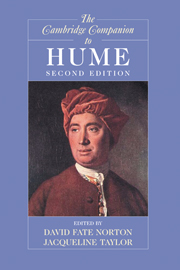Book contents
- Frontmatter
- 1 An Introduction to Hume’s Thought
- 2 Hume’s New Science of the Mind
- 3 Hume and the Mechanics of Mind: Impressions, Ideas, and Association
- 4 Hume’s Theory of Space and Time in Its Skeptical Context
- 5 Hume on Causation
- 6 Hume and the Problem of Personal Identity
- 7 Hume’s Skepticism
- 8 Hume’s Moral Psychology
- 9 The Foundations of Morality in Hume’s Treatise
- 10 Hume’s Later Moral Philosophy
- 11 The Structure of Hume’s Political Theory
- 12 Hume’s Principles of Political Economy
- 13 Hume on the Arts and “The Standard of Taste”: Texts and Contexts
- 14 David Hume: “The Historian”
- 15 Hume on Religion
- Appendix: Hume’s Autobiographies
- Selected Bibliography
- Index
- Series List
13 - Hume on the Arts and “The Standard of Taste”: Texts and Contexts
Published online by Cambridge University Press: 28 May 2009
- Frontmatter
- 1 An Introduction to Hume’s Thought
- 2 Hume’s New Science of the Mind
- 3 Hume and the Mechanics of Mind: Impressions, Ideas, and Association
- 4 Hume’s Theory of Space and Time in Its Skeptical Context
- 5 Hume on Causation
- 6 Hume and the Problem of Personal Identity
- 7 Hume’s Skepticism
- 8 Hume’s Moral Psychology
- 9 The Foundations of Morality in Hume’s Treatise
- 10 Hume’s Later Moral Philosophy
- 11 The Structure of Hume’s Political Theory
- 12 Hume’s Principles of Political Economy
- 13 Hume on the Arts and “The Standard of Taste”: Texts and Contexts
- 14 David Hume: “The Historian”
- 15 Hume on Religion
- Appendix: Hume’s Autobiographies
- Selected Bibliography
- Index
- Series List
Summary
Hume's observations on the arts are set in the framework of social life. That is why he considers both the making of, and response to, works of art as human actions subject to the analysis he has offered of other human actions. He never published his intended treatise on “criticism” (T Adv.), and no developed theories of beauty, art, or criticism are to be found in his works. But by bringing together his scattered remarks on these subjects, and by looking at his general aims and the context in which he wrote, we can identify his principal views on these topics.
Cultural Context
It is always important to establish the context and date of a writer's views; it is especially important when setting out Hume's ideas on what today we call aesthetics. His interests and references, in almost every respect except the crucial one of classical literature, were narrower than those of an informed modern reader. We need to know what he might, and what he could not, have experienced, and to recognize that his cultural environment differed essentially from ours: concepts of, and attitudes to, the various mediums of art in the 1740s were evolving rapidly, as were artistic practices and expectations. Excepting only the very rich, and their households, most Scots and the majority of the English had very limited access to what count as the arts today.
- Type
- Chapter
- Information
- The Cambridge Companion to Hume , pp. 414 - 446Publisher: Cambridge University PressPrint publication year: 2008
- 1
- Cited by

